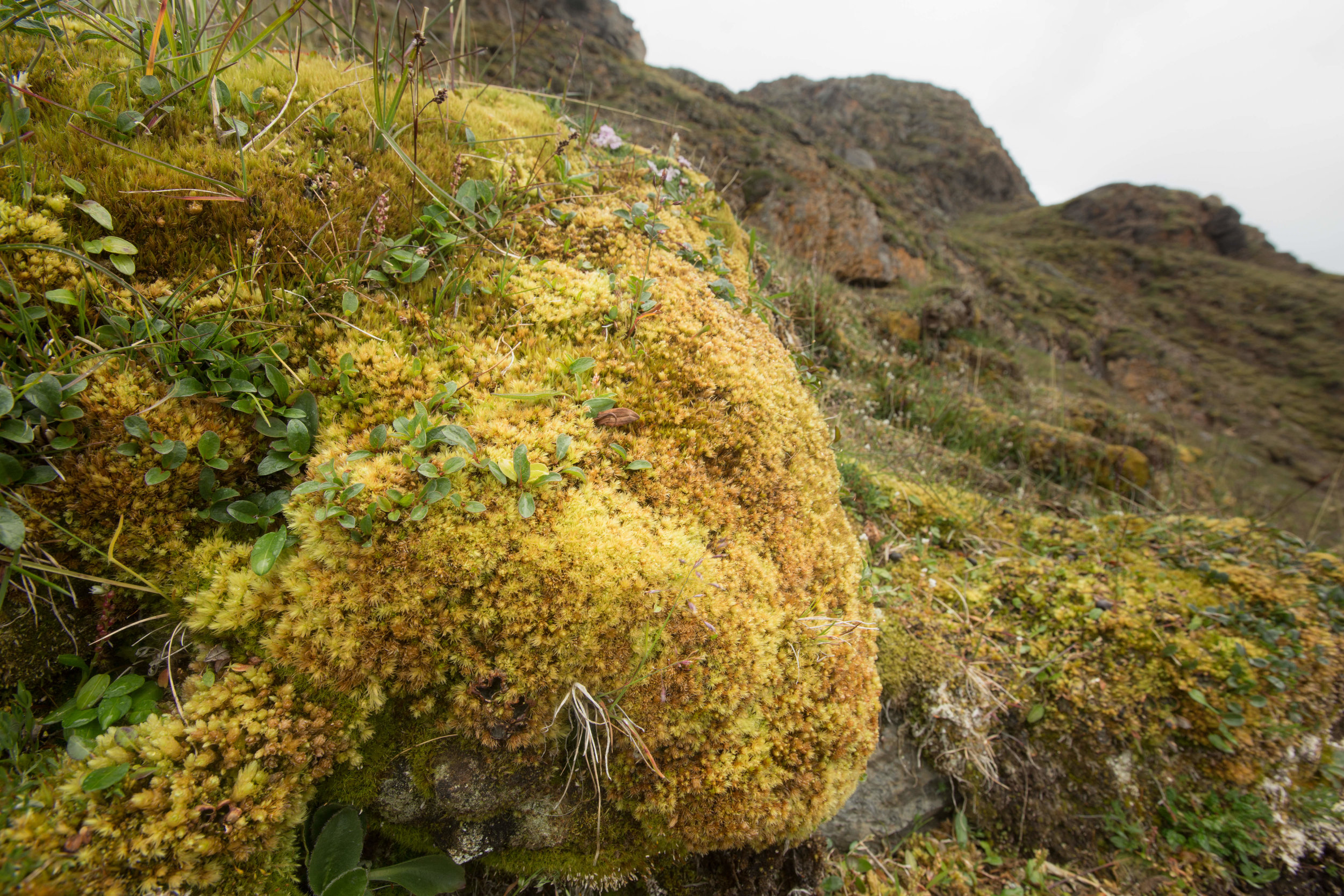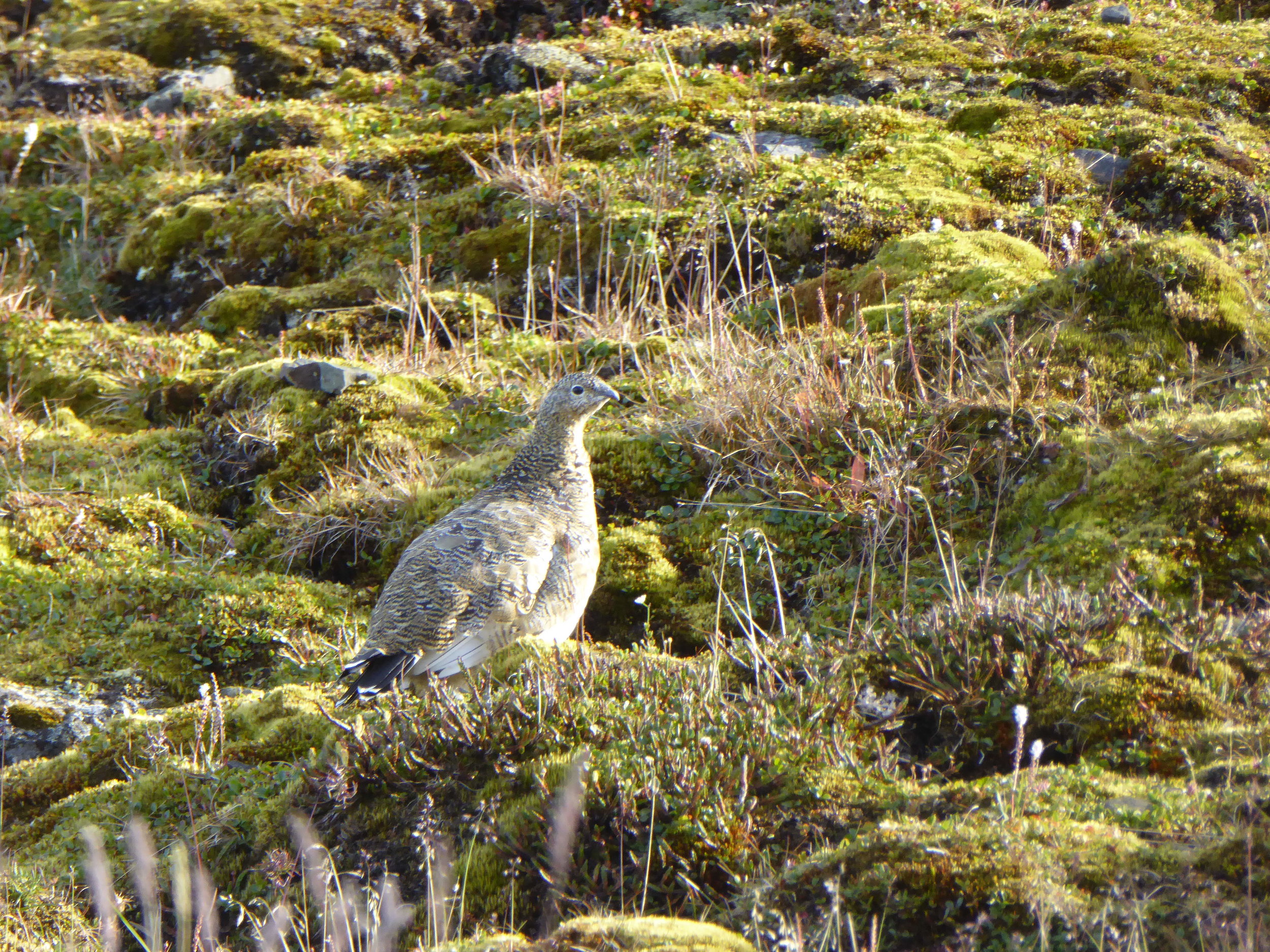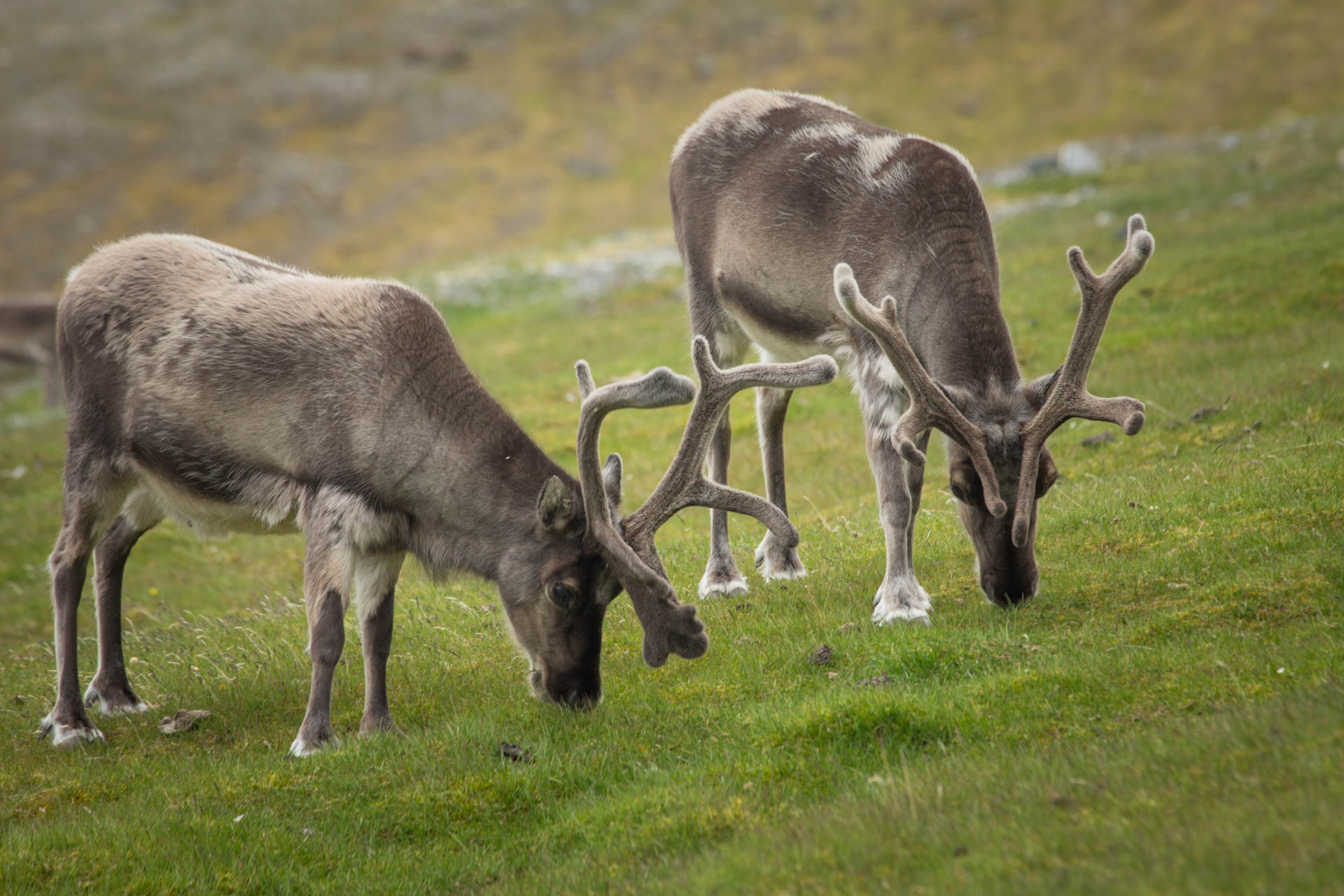The Green Arctic – Plants as Cornerstones in Terrestrial Ecosystems
SCIENCE
Virve Ravolainen & Åshild Ønvik Pedersen / Norwegian Polar Institute
Ingibjörg Svala Jónsdóttir & Mads Forchhammer / University Centre in Svalbard + University of Iceland
Eeva Soininen / UiT The Arctic University of Norway
René van der Wal / University of Aberdeen
Svalbard’s arctic landscape is characterised by glaciers, snow, barren mountains, and rocky soil.
It’s a tough place for all living organisms, yet many creatures thrive here. They owe their survival to hardy plants: mosses, grasses, and herbs are the cornerstone of Svalbard’s terrestrial ecosystem.
Much of Svalbard is an arctic desert. Satellite photos show very little vegetation, and visitors must look close to admire the small, scattered flowers that hunker down among stones and gravel. But this land in the far north has green spots. We find small patches of productive vegetation, with a diverse flora of grasses, herbs, and mosses. These plants are crucially important for the successful functioning of the entire land-based system. Without them, there would be no reindeer, no ptarmigan, no geese. The permafrost would thaw more easily and erosion would increase. Plants are the foundation on which the terrestrial food web rests. In our research, we focus on these green “cornerstones” and factors that could alter their resilience and function, with the aim of making plant monitoring both efficient and relevant for management of the ecosystem as a whole.
Why monitor the green stuff?
At present, the life of a plant in Svalbard not rosy. Weather conditions in both summer and winter vary more than they used to. The summers are warmer but also either wetter or drier than they were a few decades ago. The winters are not as cold as before, and it rains more. People come in large and small hordes and make tracks that leave their mark on the vegetation. Thousands of year-round residents (reindeer and ptarmigan) need to eat, and the same goes for a rapidly growing number of summer visitors (geese). In 1965, about 15 000 pink-footed geese came to Svalbard every year to breed; by 2016 their numbers had increased almost fivefold. Yet, cliff-breeding seabirds are declining, and thereby the amounts of natural fertiliser raining down from numerous cliffs.
According to the Svalbard Environmental Protection Act, Svalbard’s natural environment is to be preserved as untouched by humans as possible. The knowledge obtained through monitoring is expected to inform this management objective. By monitoring Svalbard’s “green stuff” we will obtain insight into the most important ongoing changes affecting the high-arctic vegetation, and distinguish between human impact and natural variation where possible. The monitoring will inform us about the consequences of climate change. We need to pay particularly close attention to those components of the vegetation that have important roles in the wider ecosystem.
What are we on the lookout for?
Svalbard’s flora includes 180 vascular plant species and more than 300 species of mosses, lichens, and liverworts. Combined in diverse assemblages, they form many different types of vegetation that vary greatly in their potential for change and their ability to tolerate disturbance by both humans and animals. Svalbard is vast, and it is impossible to monitor all the plant species or vegetation types across the whole of the archipelago. In deciding what to monitor, we use the principles described in COAT – Climate-ecological Observatory for Arctic Tundra (see Ims et al. 2013). A selection based on key concepts (e.g. sensitivity to climate change / key function in the food web / maintaining Arctic biodiversity and ecosystem services / management relevance) ensures efficient monitoring.
Mosses and friends: food web cornerstones
How rapidly plants are able to increase their biomass when affected by changes in climate or other environmental factors, such as grazing animals, is often linked to a plants’ inherent growth rate. Given good growing conditions, vegetation characterised by herbs and grass can burgeon rapidly. On the other hand, slow-growing, woody plants such as polar willow and arctic bell heather will be unable to increase their biomass as quickly. If we imagine a world where the summers become warmer and longer, and there is enough moisture for mosses to remain in place and form an intact layer, then the productive grass and herb species will have a protective blanket of moss in which to thrive. Even today, under the harshest climate conditions in the north of Svalbard, the mountain slopes are green with moss, herbs and grass – vegetation that stands out in an otherwise barren landscape. This indicates the potential of even the far north in terms of plant productivity.
Mosses and their friends – grasses and herbs – do more than just ensure a rich diversity of common plant species: they also provide a home for species that are rare in Svalbard. Insect and microorganism diversity is high in productive vegetation, and moss tundra provides vital food for Svalbard’s endemic animals, the Svalbard reindeer and the Svalbard rock ptarmigan. Herbs and grasses decompose quickly, keeping nutrients in circulation. Grass roots can stabilise the soil, and a thick carpet of moss keeps the ground cold, so that the permafrost thaws more slowly and little of the “old” carbon that is locked below the surface is not released to the atmosphere. Moss tundra is an important part of the landscape and a distinctive arctic ecosystem – and it has the potential to change rapidly. The tiny herbs, the somewhat anonymous grasses and the ubiquitous mosses that together form the moss tundra vegetation serve as “cornerstones”, forming the foundation on which much of the terrestrial arctic ecosystem rests.
The wild cards
Climate does not change in isolation, and warming is not the only environmental challenge facing the plants. When we put our imaginary world to one side and include factors from real life, it immediately becomes more difficult to predict what plant species will thrive under future environmental conditions. The grazing by Svalbard reindeer and geese, the trampling feet of grazing animals and humans, the fertilising effect of seabirds and grazers, and the arrival of plant species from outside of Svalbard: all these are wild cards that could turn everything upside down. The seabirds nesting on cliffs deposit tonnes of guano, thus bringing fresh nutrients from sea to land. Many of the seabird populations are decreasing and we do not know how long it will take before the reduced influx of fertiliser will start to limit plant growth. The grazing animal populations are affected by climate both in Svalbard (for instance the stationary Svalbard reindeer) and in the wintering areas further south (for instance the migratory pink-footed goose).
The pristine Arctic attracts tourists, who often visit seabird cliffs or moss tundra where the vegetation is susceptible to trampling. In places where the moss cover has been trampled and lost, the risk of soil warming will increase, leading to less permafrost and greater danger of landslides and ground collapse. People and animals from afar can also bring in plants that are alien to Svalbard’s flora. The moss tundra and the seabird cliffs are in particular danger as potential sites for the spread of species such as the “black-listed” cow parsley. If we are to be able to understand future changes in Svalbard’s plant life, we must keep a sharp eye on both the climate changes and the “wild cards”.
What’s the best way monitor vegetation?
We want our vegetation monitoring to be comprehensive, yet efficient. In COAT (Climate-ecological Observatory of Arctic Tundra), we are constructing a vegetation monitoring strategy that focusses on the green cornerstones of the terrestrial ecosystem: the plants in moss tundra. We combine the data we gather about plants with measurements of factors that can alter the strength and function of the cornerstone species. To do this, we link climate-related data (snow, ice, temperature, etc.) and time series of grazing animals to our data on plants, simultaneously keeping an eye on trampling and incoming non-native plant species. In this manner, we will make the vegetation monitoring relevant for the management of Svalbard’s terrestrial ecosystem.
Efficient monitoring of vegetation requires a combination of new technology and good old-fashioned field biology. Satellite images are constantly improving, and we can use them to monitor some aspects of changes in the vegetation. However, this kind of remote sensing leaves a lot of uncertainty as to which plants are actually changing. In addition, as we have seen above, the various plants and types of vegetation play widely different roles, and we need more knowledge about that as well. Therefore, we will combine remote sensing with field monitoring such that we can reveal how changes in climatic conditions, grazing animals, cliff-breeding seabirds, and a set of specific human activities influence moss tundra across large parts of Svalbard.
Combining of site-specific fieldwork and large-scale remote sensing material also brings other clear benefits. Climate models that provide maps predicting snow distribution, for example, or temperatures throughout the year’s seasons are crucially dependent on correct input data from field measurements. There are currently not enough climate observations to give adequate spatial resolution. Our vegetation monitoring strategy therefore includes gathering field data for selected climate variables.
A lot of vegetation-based research has been done previously in various locations across Svalbard, and many of those sites have been selected for COAT long-term monitoring. That way, location-specific understanding can be built from, and supplemented with data from other sites for which no such longer-term data exist. Findings from this network of monitoring sites – old and new – will be combined with monitoring of the grazing animals and climate and scaled up through the use of remote sensing approaches. By keeping an eye on the plants that are cornerstones of Svalbard’s tundra ecosystem, COAT vegetation monitoring will itself become a cornerstone in efforts to monitor wider terrestrial ecosystems.
Further reading:
Ims RA, Jepsen JU, Stien A, Yoccoz NG (2013) Science plan for COAT: Climate-ecological observatory for arctic tundra. Fram Centre, Tromsø. Available at www.coat.no
Pedersen ÅØ, Stien A, Soininen E, Ims RA (2016) Climate-ecological observatory for arctic tundra – Status 2016. Fram Forum 2016, 36-43
The authors of this article are collaborating on establishing plant monitoring within COAT – Climate-Ecological Observatory for Arctic Tundra.






